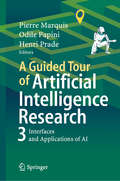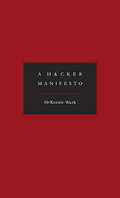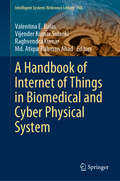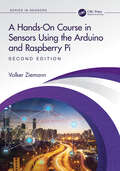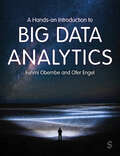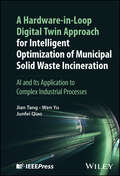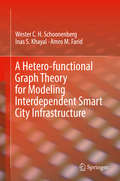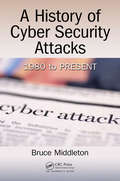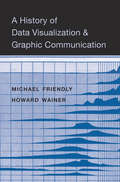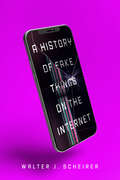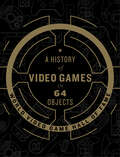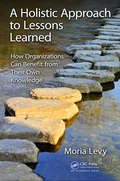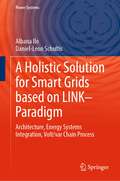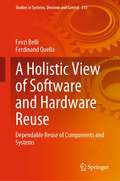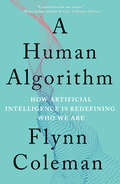- Table View
- List View
A Guided Tour of Artificial Intelligence Research: Volume III: Interfaces and Applications of Artificial Intelligence
by Henri Prade Pierre Marquis Odile PapiniThe purpose of this book is to provide an overview of AI research, ranging from basic work to interfaces and applications, with as much emphasis on results as on current issues. It is aimed at an audience of master students and Ph.D. students, and can be of interest as well for researchers and engineers who want to know more about AI. The book is split into three volumes: - the first volume brings together twenty-three chapters dealing with the foundations of knowledge representation and the formalization of reasoning and learning (Volume 1. Knowledge representation, reasoning and learning) - the second volume offers a view of AI, in fourteen chapters, from the side of the algorithms (Volume 2. AI Algorithms) - the third volume, composed of sixteen chapters, describes the main interfaces and applications of AI (Volume 3. Interfaces and applications of AI). This third volume is dedicated to the interfaces of AI with various fields, with which strong links exist either at the methodological or at the applicative levels. The foreword of this volume reminds us that AI was born for a large part from cybernetics. Chapters are devoted to disciplines that are historically sisters of AI: natural language processing, pattern recognition and computer vision, and robotics. Also close and complementary to AI due to their direct links with information are databases, the semantic web, information retrieval and human-computer interaction. All these disciplines are privileged places for applications of AI methods. This is also the case for bioinformatics, biological modeling and computational neurosciences. The developments of AI have also led to a dialogue with theoretical computer science in particular regarding computability and complexity. Besides, AI research and findings have renewed philosophical and epistemological questions, while their cognitive validity raises questions to psychology. The volume also discusses some of the interactions between science and artistic creation in literature and in music. Lastly, an epilogue concludes the three volumes of this Guided Tour of AI Research by providing an overview of what has been achieved by AI, emphasizing AI as a science, and not just as an innovative technology, and trying to dispel some misunderstandings.
A Hacker Manifesto
by McKenzie WarkA double is haunting the world—the double of abstraction, the virtual reality of information, programming or poetry, math or music, curves or colorings upon which the fortunes of states and armies, companies and communities now depend. The bold aim of this book is to make manifest the origins, purpose, and interests of the emerging class responsible for making this new world—for producing the new concepts, new perceptions, and new sensations out of the stuff of raw data. A Hacker Manifesto deftly defines the fraught territory between the ever more strident demands by drug and media companies for protection of their patents and copyrights and the pervasive popular culture of file sharing and pirating. This vexed ground, the realm of so-called “intellectual property,” gives rise to a whole new kind of class conflict, one that pits the creators of information—the hacker class of researchers and authors, artists and biologists, chemists and musicians, philosophers and programmers—against a possessing class who would monopolize what the hacker produces. Drawing in equal measure on Guy Debord and Gilles Deleuze, A Hacker Manifesto offers a systematic restatement of Marxist thought for the age of cyberspace and globalization. In the widespread revolt against commodified information, McKenzie Wark sees a utopian promise, beyond the property form, and a new progressive class, the hacker class, who voice a shared interest in a new information commons.
A Hacker's Mind: How the Powerful Bend Society's Rules, and How to Bend them Back
by Bruce SchneierIt’s not just computers—hacking is everywhere. Legendary cybersecurity expert and New York Times best-selling author Bruce Schneier reveals how using a hacker’s mindset can change how you think about your life and the world. A hack is any means of subverting a system’s rules in unintended ways. The tax code isn’t computer code, but a series of complex formulas. It has vulnerabilities; we call them “loopholes.” We call exploits “tax avoidance strategies.” And there is an entire industry of “black hat” hackers intent on finding exploitable loopholes in the tax code. We call them accountants and tax attorneys. In A Hacker’s Mind, Bruce Schneier takes hacking out of the world of computing and uses it to analyze the systems that underpin our society: from tax laws to financial markets to politics. He reveals an array of powerful actors whose hacks bend our economic, political, and legal systems to their advantage, at the expense of everyone else. Once you learn how to notice hacks, you’ll start seeing them everywhere—and you’ll never look at the world the same way again. Almost all systems have loopholes, and this is by design. Because if you can take advantage of them, the rules no longer apply to you. Unchecked, these hacks threaten to upend our financial markets, weaken our democracy, and even affect the way we think. And when artificial intelligence starts thinking like a hacker—at inhuman speed and scale—the results could be catastrophic. But for those who would don the “white hat,” we can understand the hacking mindset and rebuild our economic, political, and legal systems to counter those who would exploit our society. And we can harness artificial intelligence to improve existing systems, predict and defend against hacks, and realize a more equitable world.
A Handbook of Internet of Things in Biomedical and Cyber Physical System (Intelligent Systems Reference Library #165)
by Raghvendra Kumar Valentina E. Balas Vijender Kumar Solanki Md. Atiqur Rahman AhadThis book presents a compilation of state-of-the-art work on biomedical and cyber-physical systems in connection with the Internet of Things, and successfully blends theory and practice. The book covers the studies belonging to Biomedical and Cyber-physical System, so it is a unique effort by the research experts, who are divulging in the domain deeply. The book is very easy for the audience, who are doing study in the Biomedical and Cyber-physical System; it helps to read some real-time scenarios from where the reader in general gets many sparking ideas to convert it into the research problems in their studies. This book is of use to solve down the problems of graduate, postgraduate, doctoral industry executives, who are involving in the cutting-edge work of Internet of Things with Biomedical or Cyber-physical System, with the help of real-time solutions, given in the formation of chapters by subject’s experts.The key uses of this book are in the area of Internet of Things in connection with Cyber-physical System as well as Biomedical domain.
A Handbook of Statistical Analyses Using S-PLUS
by Brian S. EverittSince the first edition of this book was published, S-PLUS has evolved markedly with new methods of analysis, new graphical procedures, and a convenient graphical user interface (GUI). Today, S-PLUS is the statistical software of choice for many applied researchers in disciplines ranging from finance to medicine. Combining the command line languag
A Hands-On Course in Sensors Using the Arduino and Raspberry Pi (Series in Sensors)
by Volker ZiemannA Hands-On Course in Sensors Using the Arduino and Raspberry Pi is the first book to give a practical and wide-ranging account of how to interface sensors and actuators with micro-controllers, Raspberry Pi and other control systems. The author describes the progression of raw signals through conditioning stages, digitization, data storage and presentation. The collection, processing, and understanding of sensor data plays a central role in industrial and scientific activities. This book builds simplified models of large industrial or scientific installations that contain hardware and other building blocks, including services for databases, web servers, control systems, and messaging brokers. A range of case studies are included within the book, including a weather station, ground-vibration measurements, impedance measurements, interfacing medical sensors to web browsers, the profile of a laser beam, and a remote-controlled and fire-seeking robot. This second edition has been updated throughout to reflect new hardware and software releases since the book was first published. Newly added features include the ESP32 microcontroller, several environmental and medical sensors, actuators for signal generation, as well as a chapter on web sockets; all illustrated in new case studies. This book is suitable for advanced undergraduate and graduate students taking hands-on laboratory courses in physics and engineering. Hobbyists in robotics clubs and other enthusiasts will also find this book of interest. Features: Includes practical, hands-on exercises that can be conducted in student labs, or even at home Covers the latest software and hardware, and all code featured in examples is discussed in detail All steps are illustrated with practical examples and case studies to enhance learning https://github.com/volkziem/HandsOnSensors2ed Volker Ziemann obtained his PhD in accelerator physics from Dortmund University in 1990. After post-doctoral positions in Stanford at SLAC and in Geneva at CERN, where he worked on the design of the LHC, in 1995 he moved to Uppsala where he worked at the electron-cooler storage ring CELSIUS. In 2005 he moved to the physics department where he has since taught physics. He was responsible for several accelerator physics projects at CERN, DESY and XFEL. In 2014 he received the Thuréus prize from the Royal Society of Sciences in Uppsala.
A Hands-on Introduction to Big Data Analytics
by Funmi Obembe Ofer EngelThis practical textbook offers a hands-on introduction to big data analytics, helping you to develop the skills required to hit the ground running as a data professional. It complements theoretical foundations with an emphasis on the application of big data analytics, illustrated by real-life examples and datasets. Containing comprehensive coverage of all the key topics in this area, this book uses open-source technologies and examples in Python and Apache Spark. Learning features include: - Ethics by Design encourages you to consider data ethics at every stage. - Industry Insights facilitate a deeper understanding of the link between what you are studying and how it is applied in industry. - Datasets, questions, and exercises give you the opportunity to apply your learning. Dr Funmi Obembe is the Head of Technology at the Faculty of Arts, Science and Technology, University of Northampton. Dr Ofer Engel is a Data Scientist at the University of Groningen.
A Hands-on Introduction to Big Data Analytics
by Funmi Obembe Ofer EngelThis practical textbook offers a hands-on introduction to big data analytics, helping you to develop the skills required to hit the ground running as a data professional. It complements theoretical foundations with an emphasis on the application of big data analytics, illustrated by real-life examples and datasets. Containing comprehensive coverage of all the key topics in this area, this book uses open-source technologies and examples in Python and Apache Spark. Learning features include: - Ethics by Design encourages you to consider data ethics at every stage. - Industry Insights facilitate a deeper understanding of the link between what you are studying and how it is applied in industry. - Datasets, questions, and exercises give you the opportunity to apply your learning. Dr Funmi Obembe is the Head of Technology at the Faculty of Arts, Science and Technology, University of Northampton. Dr Ofer Engel is a Data Scientist at the University of Groningen.
A Hardware-in-Loop Digital Twin Approach for Intelligent Optimization of Municipal Solid Waste Incineration: AI and Its Application to Complex Industrial Processes
by Wen Yu Jiang Tang Junfei QiaoAn expert discussion of intelligent optimization control in complex industrial processes In A Hardware-in-Loop Digital Twin Approach for Intelligent Optimization of Municipal Solid Waste Incineration: AI and Its Application to Complex Industrial Processes, a team of distinguished researchers delivers an innovative new approach to integrating virtual mechanism data generated through coupled numerical simulation and orthogonal experimental design with real historical data. The book explains how to create a heterogenous ensemble prediction model for carbon monoxide emissions in municipal solid waste incineration (MSWI) processes. The authors focus on intelligent optimization control of MSWI processes based on hardware-in-loop DT platforms. They demonstrate AI-driven modeling, control, optimization algorithms in real-world applications, including virtual-real data hybrid-driven deep modeling and intelligent optimal controls based on multiple objectives. Additional topics include: A thorough introduction to numerical simulation modeling of whole industrial processesComprehensive explorations of the design, implementation, and validation of hardware-in-loop digital twin platformsPractical discussions of AI-driven modeling, control, and optimizationFulsome descriptions of the skills required to address challenges posed by complex industrial processes Perfect for environmental engineers and researchers, A Hardware-in-Loop Digital Twin Approach for Intelligent Optimization of Municipal Solid Waste Incineration will also benefit MSWI plant operators and managers, as well as AI and machine learning researchers and developers of environmental monitoring and control systems.
A Hetero-functional Graph Theory for Modeling Interdependent Smart City Infrastructure
by Amro M. Farid Inas S. Khayal Wester C. SchoonenbergCities have always played a prominent role in the prosperity of civilization. Indeed, every great civilization we can think of is associated with the prominence of one or more thriving cities. And so understanding cities -- their inhabitants, their institutions, their infrastructure -- what they are and how they work independently and together -- is of fundamental importance to our collective growth as a human civilization. Furthermore, the 21st century “smart” city, as a result global climate change and large-scale urbanization, will emerge as a societal grand challenge. This book focuses on the role of interdependent infrastructure systems in such smart cities especially as it relates to timely and poignant questions about resilience and sustainability. In particular, the goal of this book is to present, in one volume, a consistent Hetero-Functional Graph Theoretic (HFGT) treatment of interdependent smart city infrastructures as an overarching application domain of engineering systems. This work may be contrasted to the growing literature on multi-layer networks, which despite significant theoretical advances in recent years, has modeling limitations that prevent their real-world application to interdependent smart city infrastructures of arbitrary topology. In contrast, this book demonstrates that HFGT can be applied extensibly to an arbitrary number of arbitrarily connected topologies of interdependent smart city infrastructures. It also integrates, for the first time, all six matrices of HFGT in a single system adjacency matrix. The book makes every effort to be accessible to a broad audience of infrastructure system practitioners and researchers (e.g. electric power system planners, transportation engineers, and hydrologists, etc.). Consequently, the book has extensively visualized the graph theoretic concepts for greater intuition and clarity. Nevertheless, the book does require a common methodological base of its readers and directs itself to the Model-Based Systems Engineering (MBSE) community and the Network Science Community (NSC). To the MBSE community, we hope that HFGT will be accepted as a quantification of many of the structural concepts found in model-based systems engineering languages like SysML. To the NSC, we hope to present a new view as how to construct graphs with fundamentally different meaning and insight. Finally, it is our hope that HFGT serves to overcome many of the theoretical and modeling limitations that have hindered our ability to systematically understand the structure and function of smart cities.
A History of Communications
by Marshall T. PoeA History of Communications advances a new theory of media that explains the origins and impact of different forms of communication – speech, writing, print, electronic devices and the Internet – on human history in the long term. New media are 'pulled' into widespread use by broad historical trends and these media, once in widespread use, 'push' social institutions and beliefs in predictable directions. This view allows us to see for the first time what is truly new about the Internet, what is not, and where it is taking us.
A History of Cyber Security Attacks: 1980 to Present
by Bruce MiddletonStories of cyberattacks dominate the headlines. Whether it is theft of massive amounts of personally identifiable information or the latest intrusion of foreign governments in U.S. government and industrial sites, cyberattacks are now important. For professionals and the public, knowing how the attacks are launched and succeed is vital to ensuring cyber security. The book provides a concise summary in a historical context of the major global cyber security attacks since 1980. Each attack covered contains an overview of the incident in layman terms, followed by a technical details section, and culminating in a lessons learned and recommendations section.
A History of Data Visualization and Graphic Communication
by Howard Wainer Michael FriendlyA comprehensive history of data visualization—its origins, rise, and effects on the ways we think about and solve problems. With complex information everywhere, graphics have become indispensable to our daily lives. Navigation apps show real-time, interactive traffic data. A color-coded map of exit polls details election balloting down to the county level. Charts communicate stock market trends, government spending, and the dangers of epidemics. A History of Data Visualization and Graphic Communication tells the story of how graphics left the exclusive confines of scientific research and became ubiquitous. As data visualization spread, it changed the way we think. Michael Friendly and Howard Wainer take us back to the beginnings of graphic communication in the mid-seventeenth century, when the Dutch cartographer Michael Florent van Langren created the first chart of statistical data, which showed estimates of the distance from Rome to Toledo. By 1786 William Playfair had invented the line graph and bar chart to explain trade imports and exports. In the nineteenth century, the “golden age” of data display, graphics found new uses in tracking disease outbreaks and understanding social issues. Friendly and Wainer make the case that the explosion in graphical communication both reinforced and was advanced by a cognitive revolution: visual thinking. Across disciplines, people realized that information could be conveyed more effectively by visual displays than by words or tables of numbers. Through stories and illustrations, A History of Data Visualization and Graphic Communication details the 400-year evolution of an intellectual framework that has become essential to both science and society at large.
A History of Fake Things on the Internet
by Walter ScheirerA Next Big Idea Club "Must Read" for December 2023 As all aspects of our social and informational lives increasingly migrate online, the line between what is "real" and what is digitally fabricated grows ever thinner—and that fake content has undeniable real-world consequences. A History of Fake Things on the Internet takes the long view of how advances in technology brought us to the point where faked texts, images, and video content are nearly indistinguishable from what is authentic or true. Computer scientist Walter J. Scheirer takes a deep dive into the origins of fake news, conspiracy theories, reports of the paranormal, and other deviations from reality that have become part of mainstream culture, from image manipulation in the nineteenth-century darkroom to the literary stylings of large language models like ChatGPT. Scheirer investigates the origins of Internet fakes, from early hoaxes that traversed the globe via Bulletin Board Systems (BBSs), USENET, and a new messaging technology called email, to today's hyperrealistic, AI-generated Deepfakes. An expert in machine learning and recognition, Scheirer breaks down the technical advances that made new developments in digital deception possible, and shares behind-the-screens details of early Internet-era pranks that have become touchstones of hacker lore. His story introduces us to the visionaries and mischief-makers who first deployed digital fakery and continue to influence how digital manipulation works—and doesn't—today: computer hackers, digital artists, media forensics specialists, and AI researchers. Ultimately, Scheirer argues that problems associated with fake content are not intrinsic properties of the content itself, but rather stem from human behavior, demonstrating our capacity for both creativity and destruction.
A History of Video Games in 64 Objects
by World Video Game Hall of FameInspired by the groundbreaking A History of the World in 100 Objects, this book draws on the unique collections of The Strong museum in Rochester, New York, to chronicle the evolution of video games, from Pong to first-person shooters, told through the stories of dozens of objects essential to the field’s creation and development.Drawing on the World Video Game Hall of Fame’s unmatched collection of video game artifacts, this fascinating history offers an expansive look at the development of one of the most popular and influential activities of the modern world: video gaming.Sixty-four unique objects tell the story of the video game from inception to today. Pithy, in-depth essays and photographs examine each object’s significance to video game play—what it has contributed to the history of gaming—as well as the greater culture.A History of Video Games in 64 Objects explains how the video game has transformed over time. Inside, you’ll find a wide range of intriguing topics, including:The first edition of Dungeons & Dragons—the ancestor of computer role-playing gamesThe Oregon Trail and the development of educational gamingThe Atari 2600 and the beginning of the console revolutionA World of Warcraft server blade and massively multiplayer online gamesMinecraft—the backlash against the studio systemThe rise of women in gaming represented by pioneering American video game designers Carol Shaw and Roberta Williams’ game development materialsThe prototype Skylanders Portal of Power that spawned the Toys-to-Life video game phenomenon and shook up the marketplaceAnd so much more!A visual panorama of unforgettable anecdotes and factoids, A History of Video Games in 64 Objects is a treasure trove for gamers and pop culture fans. Let the gaming begin!
A History of the Office and Office Work: From Castle to Condominium
by Rob HarrisThis book brings together the office and office working as an economic construct, as a business function, as a building type and as a mode of work. It explores social and economic relations, and it traces the evolution of work and the environment and equipment needed to support it over the last 400 years. In so doing, it helps to fill a void in popular understanding of the office.The role of the office has been examined over the past three years in ways that it has never been examined before. Whilst the existential crisis arising from COVID-19 has settled somewhat, there remain big questions over the future of office workers and office real estate. This book is a timely, well-researched and fascinating contribution to the debate.Rob Harris explores how the nature of work has changed, and continues to change, placing the events surrounding COVID-19 into a longer-term perspective and asking what is the future of the office? Will it go through a radical reinvention? How will office work evolve in the future? Whither office buildings? The book emphasises the continuum of change and that today’s events are simply the latest stage of change, rather than something entirely novel.This book will be of interest to anyone with a stake in the built environment, whether as an investor, occupier, owner, manager or advisor. It is equally accessible to those with a non-technical background, including students on courses such as economic history, economics, geography, real estate and urban planning.
A Hitchhiker's Guide to Virtual Reality
by Karen McMenemy Robin Stuart FergusonA Hitchhiker's Guide to Virtual Reality brings together under one cover all the aspects of graphics, video, audio, and haptics that have to work together to make virtual reality a reality. Like any good guide, it reveals the practical things you need to know, from the viewpoint of authors who have been there. This two-part guide covers the science, technology, and mathematics of virtual reality and then details its practical implementation. The first part looks at how the interface between human senses and technology works to create virtual reality, with a focus on vision, the most important sense in virtual reality. The second part of the book is tightly integrated with an accompanying CD, which contains the programs for more than 30 virtual reality projects, ranging in scope from a tool that simulates virtual sculpting to a suite of software for the control of a four-projector immersive virtual environment.
A Holistic Approach to Lessons Learned: How Organizations Can Benefit from Their Own Knowledge
by Moria LevyThe book presents a holistic approach to organization performance improvements by lessons learned management. Such an approach is required because specific methods, such as debriefing, task management or procedures updates, do not achieve actual improvements. The presented model spans the entire life cycle of lessons learned: Starting from creating new lessons, moving on to knowledge refining and ending with smart integration into the organizational environment so future re-use of knowledge is enabled. The model also addresses other sources of organizational learning including quality processes and employee experience utilization.
A Holistic Approach to Ship Design: Volume 2: Application Case Studies
by Apostolos PapanikolaouThis book deals with modern Computer-Aided Design (CAD) software tools and platforms implemented in ship design, the integration of techno-economic databases, the use of optimisation and simulation software tools, which are integrated in these platforms, and the virtual modelling of ships and their operation by using a Virtual Vessel Framework (VVF). It contains a series of application case studies related to the developed holistic approach to ship design and operation. Nine case studies are described, referring to the design and operation of various ship types, namely RoPax, cruise ship, double-ended ferry, bulk carrier, containership, offshore support vessel, ocean surveillance ship and research vessel and one offshore structure. All case studies are driven by leading representatives of the European Maritime Industry. This book complements A Holistic Approach to Ship Design, volume 1, which covers methods and tools for the life cycle optimisation and assessment of ship design and operation.
A Holistic Solution for Smart Grids based on LINK– Paradigm: Architecture, Energy Systems Integration, Volt/var Chain Process (Power Systems)
by Albana Ilo Daniel-Leon SchultisThis book presents a holistic solution for Smart Grids that includes the electricity: producers, electricity storages, grids, market and customer plants. The authors have derived the architectural paradigm for Smart Grids LINK from the signature of their fractal structure. The presented LINK-based holistic architecture enables the large-scale integration of distributed energy resources by minimising the data to be exchanged, thus considering privacy and cyber security by design. The straightforwardness of LINK-Solution is related to its standardised structures, enabling the coupling of energy and non-energy sectors and Energy Communities. The Volt/var chain control as one of the most challenging operation processes of Smart Grids is covered in detail in this edition. Chapter by chapter, the reader is smoothly introduced to this unique solution, facilitating its practical implementation. This book is a valuable resource for experts, consultants, engineers, scientists, and students in the Smart Grids area and actors of the electricity market and politicians.
A Holistic View of Software and Hardware Reuse: Dependable Reuse of Components and Systems (Studies in Systems, Decision and Control #315)
by Ferdinand Quella Fevzi BelliThis book focuses on software reuse and the chances, dependability tests and recommendations for best reuse practice. A short introduction of the Ecodesign of hardware is given combined with the latest update of relevant EU legislation and standardization. It also describes the combination of different states of software in a E&E system in order to guarantee dependability of the product to be resold.
A Human Algorithm: How Artificial Intelligence Is Redefining Who We Are
by Flynn ColemanA groundbreaking narrative on the urgency of ethically designed AI and a guidebook to reimagining life in the era of intelligent technology.The Age of Intelligent Machines is upon us, and we are at a reflection point. The proliferation of fast–moving technologies, including forms of artificial intelligence akin to a new species, will cause us to confront profound questions about ourselves. The era of human intellectual superiority is ending, and we need to plan for this monumental shift.A Human Algorithm: How Artificial Intelligence Is Redefining Who We Are examines the immense impact intelligent technology will have on humanity. These machines, while challenging our personal beliefs and our socioeconomic world order, also have the potential to transform our health and well–being, alleviate poverty and suffering, and reveal the mysteries of intelligence and consciousness. International human rights attorney Flynn Coleman deftly argues that it is critical that we instill values, ethics, and morals into our robots, algorithms, and other forms of AI. Equally important, we need to develop and implement laws, policies, and oversight mechanisms to protect us from tech’s insidious threats.To realize AI’s transcendent potential, Coleman advocates for inviting a diverse group of voices to participate in designing our intelligent machines and using our moral imagination to ensure that human rights, empathy, and equity are core principles of emerging technologies. Ultimately, A Human Algorithm is a clarion call for building a more humane future and moving conscientiously into a new frontier of our own design.“[Coleman] argues that the algorithms of machine learning––if they are instilled with human ethics and values––could bring about a new era of enlightenment.” —San Francisco Chronicle
A Human's Guide to Machine Intelligence: How Algorithms Are Shaping Our Lives and How We Can Stay in Control
by Kartik HosanagarA Wharton professor and tech entrepreneur examines how algorithms and artificial intelligence are starting to run every aspect of our lives, and how we can shape the way they impact usThrough the technology embedded in almost every major tech platform and every web-enabled device, algorithms and the artificial intelligence that underlies them make a staggering number of everyday decisions for us, from what products we buy, to where we decide to eat, to how we consume our news, to whom we date, and how we find a job. We've even delegated life-and-death decisions to algorithms--decisions once made by doctors, pilots, and judges. In his new book, Kartik Hosanagar surveys the brave new world of algorithmic decision-making and reveals the potentially dangerous biases they can give rise to as they increasingly run our lives. He makes the compelling case that we need to arm ourselves with a better, deeper, more nuanced understanding of the phenomenon of algorithmic thinking. And he gives us a route in, pointing out that algorithms often think a lot like their creators--that is, like you and me.Hosanagar draws on his experiences designing algorithms professionally--as well as on history, computer science, and psychology--to explore how algorithms work and why they occasionally go rogue, what drives our trust in them, and the many ramifications of algorithmic decision-making. He examines episodes like Microsoft's chatbot Tay, which was designed to converse on social media like a teenage girl, but instead turned sexist and racist; the fatal accidents of self-driving cars; and even our own common, and often frustrating, experiences on services like Netflix and Amazon. A Human's Guide to Machine Intelligence is an entertaining and provocative look at one of the most important developments of our time and a practical user's guide to this first wave of practical artificial intelligence.
A Human-Centered Perspective of Intelligent Personalized Environments and Systems (Human–Computer Interaction Series)
by Marko Tkalčič Panagiotis Germanakos Bruce Ferwerda Mark GrausThis book investigates the potential of combining the more quantitative - data-driven techniques with the more qualitative - theory-driven approaches towards the design of user-centred intelligent systems. It seeks to explore the potential of incorporating factors grounded in psychological theory into adaptive/intelligent routines, mechanisms, technologies and innovations. It highlights models, methods and tools that are emerging from their convergence along with challenges and lessons learned. Special emphasis is placed on promoting original insights and paradigms with respect to latest technologies, current research trends, and innovation directions, e.g., incorporating variables derived from psychological theory and individual differences in adaptive intelligent systems so as to increase explainability, fairness, and transparency, and decrease bias during interactions while the control remains with the user.
A Hybrid Approach for Power Plant Fault Diagnostics (Studies in Computational Intelligence #743)
by Tamiru Alemu LemmaThis book provides a hybrid approach to fault detection and diagnostics. It presents a detailed analysis related to practical applications of the fault detection and diagnostics framework, and highlights recent findings on power plant nonlinear model identification and fault diagnostics. The effectiveness of the methods presented is tested using data acquired from actual cogeneration and cooling plants (CCPs). The models presented were developed by applying Neuro-Fuzzy (NF) methods. The book offers a valuable resource for researchers and practicing engineers alike.
